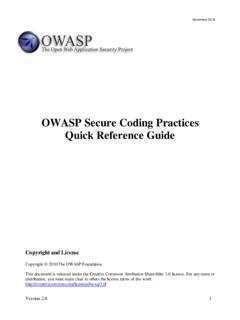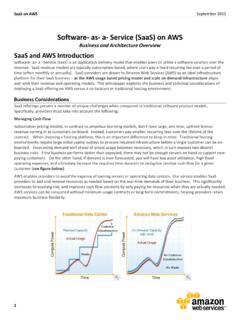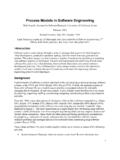Transcription of HTTP Parameter Pollution - OWASP
1 OWASP AppSecEU09 PolandCopyright The OWASP FoundationPermission is granted to copy, distribute and/or modify this document under the terms of the OWASP OWASP FoundationOWASPEU09 Parameter PollutionLuca CarettoniIndependent diPaolaCTO @ Minded AppSecEU09 Poland2 About us Luca ikki Carettoni Penetration Testing Specialist in a worldwide financial institution Security researcher for fun (and profit) OWASP Italy contributor I blog @ Keywords: web application security, ethical hacking, Java security Stefano wisec Di Paola CTO @ Minded Security Application Security Consulting Director of Research @ Minded Security Labs Lead of WAPT & Code Review Activities OWASP Italy R&D Director Sec Research (Flash Security, ) WebLogs , AppSecEU09 PolandAgenda Introduction Server enumeration HPP in a nutshell HPP Categories Server side attacks Concept Real world examples Client side attacks Concept Real world examplesOWASP AppSecEU09 PolandFact In modern web apps, several application layers are involved OWASP AppSecEU09 PolandConsequence Different input validation vulnerabilities exist SQL Injection LDAP Injection XML Injection XPath Injection Command Injection All input validation flaws are caused by unsanitized data flows between the front-end and the several back-ends of a web application Anyway, we still miss something here !
2 ?! _ _ _ InjectionOWASP AppSecEU09 PolandAn unbelievable There is no formal definition of an injection triggered by query string delimiters As far as we know, no one has never formalized an injection based attack against delimiters of the most used protocol on the web: HTTP HPP is surely around since many years, however it is definitely underestimated As a result, several vulnerabilities have been discovered in real-world applicationsOWASP AppSecEU09 PolandIntroduction 1/2 The term Query Stringis commonly used to refer to the part between the ? and the end of the URI As defined in the RFC 3986, it is a series of field-value pairs Pairs are separated by & or ; The usage of semicolon is a W3C recommendationin order to avoid escaping RFC 2396defines two classes of characters: Unreserved:a-z, A-Z, 0-9 and _ . ! ~ * ' ( ) Reserved:; / ? : @ & = + $ , OWASP AppSecEU09 PolandIntroduction 2/2 GET and POST HTTP request Query String meta characters are , =and equivalent ( using encoding) In case of multiple parameters with the same name, HTTP back-ends behave in several waysGET /foo?
3 Par1=val1&par2=val2 : : HostAccept: */*POST /foo : : HostAccept: */*Content-Length: 19par1=val1&par2=val2cOWASP AppSecEU09 PolandServer enumeration - ListOWASP AppSecEU09 PolandServer enumeration - Summing up Different web servers manage multiple occurrences in several ways Some behaviors are quite bizarre Whenever protocol details are not stronglydefined, implementations may stronglydiffer Unusualbehaviors are a usualsource of security weaknesses(MANTRA!) OWASP AppSecEU09 PolandAdditional considerations 1/2 As mentioned, ASP and concatenate the values with a comma in between This applies to the Query String and form parameters in ASP and Cookies have similar property in [ par ] par = 1,2,3,4,5,6 POST : : HostCookie: par=5; par=6 Content-Length: 19par=3&par=4 OWASP AppSecEU09 PolandAdditional considerations 2/2 Unfortunately, application behaviors in case of multiple occurrences may differ as well This is strongly connected with the specific API used by our code In Java, for example: Interface(Query String direct parsing) ( name)Returns the value of a request Parameter as a String, or null if the Parameter does not exist [] getParameterValues( name) Returns an array of String objects containing all of the values the given request Parameter has, or null if the Parameter does not exist As a result, the applications may react in unexpected you will see!
4 OWASP AppSecEU09 PolandA bizarre behavior 1/4 -HPPed! OWASP AppSecEU09 PolandA bizarre behavior 2/4 -HPPed! OWASP AppSecEU09 PolandA bizarre behavior 3/4 -HPPed! OWASP AppSecEU09 PolandA bizarre behavior 4/4 -HPPed! Since this error generates ~100 lines in the log file, it may be used to obfuscate other attacksOWASP AppSecEU09 PolandHPP in a nutshell HTTP Parameter Pollution (HPP) is a quite simple but effective hacking technique HPP attacks can be defined as the feasibility to override or add HTTP GET/POST parameters by injecting query string delimiters It affects a building block of all web technologies thus server-side and client-side attacks exist Exploiting HPP vulnerabilities, it may be possible to: Override existing hardcoded HTTP parameters Modify the application behaviors Access and, potentially exploit, uncontrollable variables Bypass input validation checkpoints and WAFs rules OWASP AppSecEU09 PolandHPP Categories We are not keen on inventing yet another buzzword.
5 However, the standard vulnerability nomenclature seems lacking this concept Classification: Client-side1. First order HPP or Reflected HPP 2. Second order HPP or Stored HPP 3. Third order HPP or DOM Based HPP Server-side1. Standard HPP2. Second order HPP According to our classification, Flash Parameter Injection* may be considered as a particular subcategory of the HPP client-side attack* AppSecEU09 PolandEncoding & GET/POST/Cookie precedence Several well-known encoding techniques may be used to inject malicious payloads The precedence of GET/POST/Cookie may influence the application behaviors and it can also be used to override parametersApache POST /foo?par1=val1&par1=val2 : occurrence, GET Parameter firstOWASP AppSecEU09 PolandHPP Server Side Attacks 1/2 Suppose some code as the following: Which is the attack surface? void private executeBackendRequest(HTTPR equest request){String amount= ("amount");String beneficiary= ("recipient");HttpRequest(" ","POST","action=transfer&amount="+amoun t+"&recipient="+beneficiary);} OWASP AppSecEU09 PolandHPP Server Side Attacks 2/2 A malicious user may send a request like: Then, the frontend will build the following back-end request: Obviously depends on how the application will manage the (" ","POST","action=transfer&amount="+amoun t+"&recipient="+beneficiary); OWASP AppSecEU09 PolandHPP Server Side - WebApp Firewalls What would happen with WAFs that do Query String parsing before applying filters?
6 HPP can be used even to bypass WAFs Some loose WAFs may analyze and validate a single Parameter occurrence only (first or last one) Whenever the devel environment concatenates multiple occurrences ( ASP, , AXIS IP Cameras, DBMan, ..), an aggressor can split the malicious payload. http:// <Payload_1>&par=<Payload_2>par=<Payload_1>~~<Payload_2> OWASP AppSecEU09 PolandHPP Server Side URL Rewriting URL Rewriting could be affected as well if regexp are too permissive:RewriteCond %{THE_REQUEST} ^[A-Z]{3,9}\ .+page\.php.*\ HTTP/RewriteRule ^page\.php.*$ - [F,L] RewriteCond %{REQUEST_FILENAME} !-fRewriteCond %{REQUEST_FILENAME} !-dRewriteRule ^([^/]+)$ $1&id=0 [L]http://host/abcbecomes:http:// AppSecEU09 PolandHPP Server Side URL Rewriting issues An attacker may try to inject:http://host/abc%26action%3dedit and the url will be rewritten as:http:// Obviously, the impact depends on the functionality exposed24 OWASP AppSecEU09 PolandReal World ExamplesServer Side AttacksOWASP AppSecEU09 PolandGoogle Search Appliance -HPPed!
7 Once upon a time, during an assessment for GSA was the LAN search engine exposed for public search as well,with only three controllable values The Parameter named afilter is used unencoded By polluting GSA parameters, appending %23 ( # ), we got full access to internal resultsOWASP AppSecEU09 PolandModSecurity -HPPed! ModSecurity SQL Injection filter bypass While the following query is properly detected Using HPP, it is possible to bypass the filter Other vendors may be affected as well This technique could potentially be extended to obfuscate attack payloads Lavakumar Kuppan is credited for this 1,2,3 from table where id=1 1&page=2,3 from table where id=1 OWASP AppSecEU09 PolandHPP Client Side attacks 1/2 HPP Client Side is about injecting additional parameters to links and other src attributes Suppose the following code: There's no XSS, but what about HPP? It s just necessary to send a request like To obtain <? $val=htmlspecialchars($_GET['par'],ENT_Q UOTES); ?
8 > <a href=" '.<?=$val?>.'">View Me!</a>http:/ <a href=" ">View Me!</a> OWASP AppSecEU09 PolandHPP Client Side attacks 2/2 Once again, it strongly depends on the functionalities of a link It's more about Anti-CSRF Functional UI Redressing It could be applied on every tag with Data, src, href attributes Action forms with POST methodOWASP AppSecEU09 PolandHPP Client Side - DOM based It's about parsing unexpected parameters It's about the interaction between IDSs and the application It's about the generation of client side HPP via JavaScript It's about the use of (XMLHttp)Requests on polluted parameters// First Occurrencefunction gup( name ){name = (/[\[]/,"\\\[").replace(/[\]]/,"\\\]");v ar regexS = "[\\?&]"+name+"=([^ var regex = new RegExp( regexS );var results = ( );if( results == null )return "";elsereturn results[1];}// Last Occurrencefunction argToObject () {var sArgs = (1).split(' var argObj={};for (var i = 0; i < ; i++) {var r=sArgs[i].))]}}
9 Split('=')argObj[r[0]]=r[1]}return argObj} OWASP AppSecEU09 PolandHPP Client Side - FPI, the HPP way As mentioned, an interesting case of HPP is the Flash Parameter Injectionby Ayal Yogev and Adi Sharabani @ Watchfire FPI is about including FlashVarsin the html itself when the vulnerable flash is directly dependent on the page itself A FPI will result in the injection of additional parameters in the paramtag Piggybacking FlashVarshttp:// <HPP> OWASP AppSecEU09 PolandReal World ExamplesClient Side AttacksOWASP AppSecEU09 -HPPed! Features: Anti XSS using HtmlEntities DOM HPP and Client Side HPP compliant! ;) OWASP AppSecEU09 PolandExcite -HPPed! Features: Several parameters could be HPPed Anti XSS using htmlEntities countermeasures DOM HPP + Client Side HPP friendly! AppSecEU09 PolandExcite -HPPed!35 Sweet dogs? Click anywhere on an This is a kind of content Pollution Even if the example seems harmless, it may help to successfully conduct social engineering attacksOWASP AppSecEU09 PolandMS IE8 XSS Filter Bypass -HPPed!
10 IE8 checks for XSS regexp in the query string parameters, as well as it searches for them in the output When there's a .NET application, multiple occurrences of a Parameter are joined using , So param=<script¶m=src= .. >becomes <script,src= .. > in HTML As you can imagine, it bypasses the IE8 XSS filter Alex Kuza is credited for this findingOWASP AppSecEU09 PolandYahoo! Mail Classic -HPPed! Features Check antiCSRF Dispatcher View Html Entities filtering, antiXSS HPP compliant! The dispatcher pattern helps the attacker %26 DEL=1%26 DelFID=Inbox%26cmd= %2526cmd= Attack payload: AppSecEU09 PolandYahoo! Mail Classic -HPPed! It s show time! Yahoo! has (silently) patched this AppSecEU09 PolandPTK Forensic -HPPed! PTK, an alternative Sleuthkit Interface PTK is a forensic tool with a web based frontend written in PHP, included in the SANS SIFT The investigator can mount a DD image and then inspect files, using the UI Here, HPP is the key to exploit a critical vulnerability**.



















